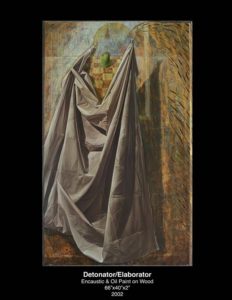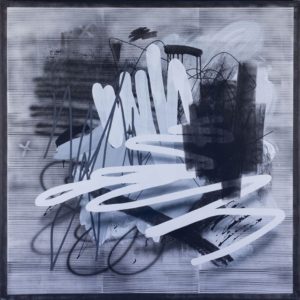Spring Exhibitions: March 22-May 26, 2018
Uncovering Surface and Silence
Kristy Deetz
Kristy Deetz’s drapery paintings on carved wood invoke and revise European canonical painting. A drapery may stand in for the body, free of specific gender connotations while still creating a human presence. The often carved surfaces in the painting construction, along with the illusionistically painted drapery images, blend painting and sculpture, and object and illusion, allowing the referents to resonate on multiple levels.

In her paintings, illusionistically painted drapery and fruit substitute for the body, a barrier between interiors (still life objects) and exteriors (landscapes, perspective lines, houses, tornadoes), or a boundary where interiors meet exteriors. The drapery embodies substance but also spirit: the point where ideas, people, cultures, and emotions cross and sometimes merge. Drapery connects dynamic with static. Drapery becomes a catalyst for exploring the conflict between belief and deed. The drapery image interweaves the autobiographical with the historical, the past with the present, the self with another–exploring the metaphorical possibilities of material, process and content resulting in multivalent outcomes where symbols and metaphors continually evolve and recycle.
101 Ways to Cook an Egg
Shane Walsh
Shane Walsh’s paintings are the result of his involvement with collage, both in a literal sense and as a conceptual framework for understanding the legacy of abstraction. Walsh’s process begins with small-scale collages constructed from photocopies of various shapes and marks – some expressive, others graphic or digital – which respond to the history of abstract painting. Using the collage as source material, he then translates his compositions into large-scale paintings. This overall approach allows him to treat the history of abstraction as a storehouse of moments from which to copy, paste, and sample. This cutting, copying, and pasting, however, owes as much to the punk and hip-hop posters of the artist’s youth as it does to modernist collage traditions.

The photocopy itself also serves as an important metaphor in Walsh’s work. Just as an image repeatedly reproduced on a copy machine will become distorted over time, so our understanding of abstraction is altered as paintings are transmitted and reproduced through time and culture. This process is akin to the children’s game of “telephone”, in which the original message often emerges drastically altered and distorted by the time it arrives at the last participant. For Walsh, these distortions are something to celebrate and provide him with the opportunity to re-construct an image of abstraction that feels appropriate to his time and place.
All work appears courtesy of the Alice Wilds Gallery, Milwaukee.